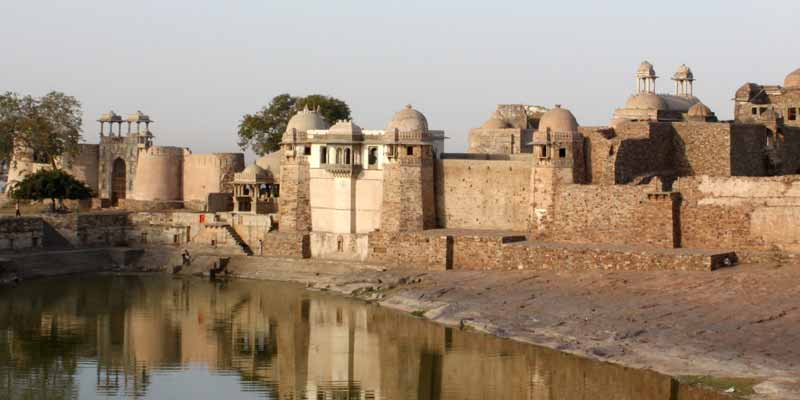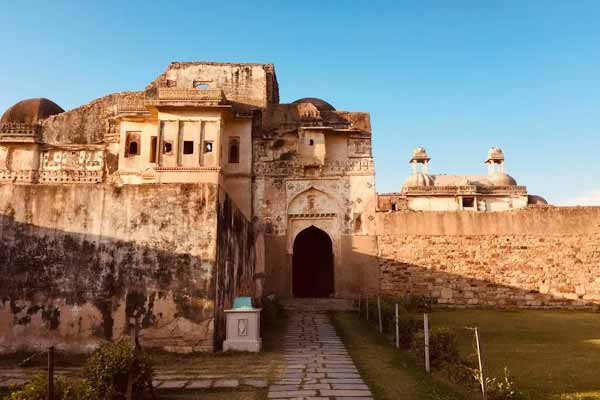Ratan Singh Palace, located within the historic Chittorgarh Fort in Rajasthan, India, stands as a testament to the rich cultural and architectural heritage of the region. This palace, also known as Ratan Singh Mahal, was constructed in the 15th century by Rana Ratan Singh, a ruler of Mewar.
The palace boasts a blend of Rajput and Mughal architectural styles, showcasing intricately carved pillars, balconies, and archways. The structure reflects the grandeur of its time, with ornate designs and detailed craftsmanship adorning its walls. Visitors can marvel at the exquisite frescoes and mural paintings that depict tales of valor, love, and historical events.
Notably, the palace is associated with the legendary tale of Rani Padmini, the queen of Rana Ratan Singh, and the siege of Chittorgarh by Alauddin Khilji. The palace’s strategic location provides panoramic views of the surrounding landscape, making it a captivating destination for history enthusiasts and tourists alike, offering a glimpse into the royal legacy of Chittorgarh Tour Packages.

History of Ratan Singh Palace
Ratan Singh Palace, located within the historic Chittorgarh Fort in Rajasthan, India, holds a significant place in the region’s rich history. The palace is named after Ratan Singh, a ruler of Mewar, who played a crucial role in the events that unfolded within the fort.
Constructed during the 15th century, Ratan Singh Palace exemplifies Rajput architecture with its impressive design and strategic location within the fort complex. The palace served as the residence of Ratan Singh, who was married to Queen Padmini. The legendary tale of Queen Padmini’s beauty and the subsequent siege of Chittorgarh by Alauddin Khilji is intricately linked to Ratan Singh Palace.
In 1303, Alauddin Khilji attacked Chittorgarh Tourism, driven by his desire to possess Queen Padmini. Ratan Singh valiantly defended the fort, but the conflict ultimately led to the fall of Chittorgarh. The palace witnessed intense battles and heroic sacrifices during this period.
Despite the tragic events, Ratan Singh Palace stands as a symbol of Rajput valor and resilience. The architectural remnants of the palace provide a glimpse into the grandeur of the bygone era and the historical turbulence that unfolded within the walls of Chittorgarh Fort. Today, the site attracts tourists and history enthusiasts, offering a tangible connection to the storied past of Rajasthan’s princely heritage.
Architecture of the Ratan Singh Palace
Ratan Singh Palace, situated within the historic Chittorgarh Fort in Rajasthan, India, is an architectural marvel that reflects the rich cultural and historical heritage of the region. The palace is named after Ratan Singh, a ruler of Mewar, and it stands as a testament to the grandeur and opulence of the Rajput architecture.
The palace boasts a unique blend of Rajput and Mughal architectural styles, showcasing intricate details, exquisite carvings, and stunning craftsmanship. The structure is characterized by its impressive courtyards, ornate balconies, and elaborately decorated interiors. The use of red sandstone in construction gives the palace a striking appearance, further enhanced by the delicate artwork and filigree designs that adorn its walls.
The layout of Ratan Singh Palace is organized around a series of courtyards and interconnected rooms, reflecting the traditional design principles of Rajput palaces. The palace also features several jharokhas (overhanging balconies) that not only serve as architectural elements but also provide panoramic views of the surrounding landscape, including the picturesque view of the Chittorgarh Fort itself.
Despite the passage of time and the impact of various invasions, Ratan Singh Palace has managed to preserve its architectural grandeur. Visitors to the palace can immerse themselves in the historical narrative of the region while marveling at the intricate architecture that stands as a testament to the glorious past of Chittorgarh. The palace serves as a living embodiment of the rich cultural legacy and architectural prowess of the Rajput rulers in medieval India.
Places to Visit Near Ratan Singh Palace
Ratan Singh Palace is a historical site located in Chittorgarh Attractions, Rajasthan, India. Chittorgarh itself is known for its rich history and cultural heritage. If you’re staying near Ratan Singh Palace and are looking for places to visit nearby, here are some recommendations:
Chittorgarh Fort: This is the largest fort in India and a UNESCO World Heritage Site. It is a must-visit for its historical significance and architectural marvels. The fort houses several palaces, temples, and towers, each with its own story.
Vijay Stambh (Victory Tower): Located within the Chittorgarh Fort, Vijay Stambh is a towering structure built by Maharana Kumbha to commemorate his victory over Mahmud Khilji. The tower offers panoramic views of the surrounding area.
Kirti Stambh (Tower of Fame): Another impressive tower within the Chittorgarh Fort, Kirti Stambh is dedicated to Adinath, the first Jain Tirthankara. The tower is adorned with intricate sculptures and carvings.
Padmini Palace: This palace is known for its association with the legendary queen Padmini. The palace overlooks a lotus pool and offers stunning views of the surroundings.
Meera Temple: Dedicated to the famous poet-saint Meera Bai, this temple is a serene and spiritual place. The temple architecture is beautiful, and it holds cultural significance.
Kalika Mata Temple: Situated near the fort, this temple is dedicated to Goddess Kali. It’s an ancient temple with a unique architectural style.
Fateh Prakash Palace: Located near the Chittorgarh Fort, this palace is now a museum that showcases a collection of sculptures and archaeological artifacts.
Gau Mukh Kund: This is a historic stepwell in Chittorgarh. It’s an interesting structure with a unique design, and it has religious significance.
Rana Kumbha Palace: Explore the ruins of Rana Kumbha’s palace, known for its grandeur and historical importance.
Bassie Wildlife Sanctuary: If you enjoy nature and wildlife, consider visiting the nearby Bassie Wildlife Sanctuary, which is home to various species of flora and fauna.
Before planning your visit, it’s advisable to check for any local restrictions, opening hours, and other relevant information to ensure a smooth and enjoyable experience.
How To Reach Ratan Singh Palace
Ratan Singh Palace is part of the historic Chittorgarh Fort in Rajasthan, India. Please note that specific details may change, so it’s advisable to check for the latest information before planning your visit. Here are general directions to reach Chittorgarh and the Ratan Singh Palace:
By Air: The nearest airport to Chittorgarh is Maharana Pratap Airport in Udaipur, which is approximately 70-80 kilometers away. From the airport, you can hire a taxi or use other modes of transportation to reach Chittorgarh.
By Train: Chittorgarh is well-connected by rail, and the Chittorgarh Railway Station is one of the largest railway stations in Rajasthan. Many trains connect Chittorgarh to major cities in India. Upon reaching the railway station, you can hire a taxi or use local transportation to reach the Chittorgarh Fort.
By Road: Chittorgarh is well-connected by road, and you can reach there by bus or car. The city is connected to major cities and towns in Rajasthan and other parts of India. You can use the National Highway network to reach Chittorgarh. Once you reach Chittorgarh, you can hire a taxi or use local transportation to get to the Chittorgarh Fort, where Ratan Singh Palace is located.
